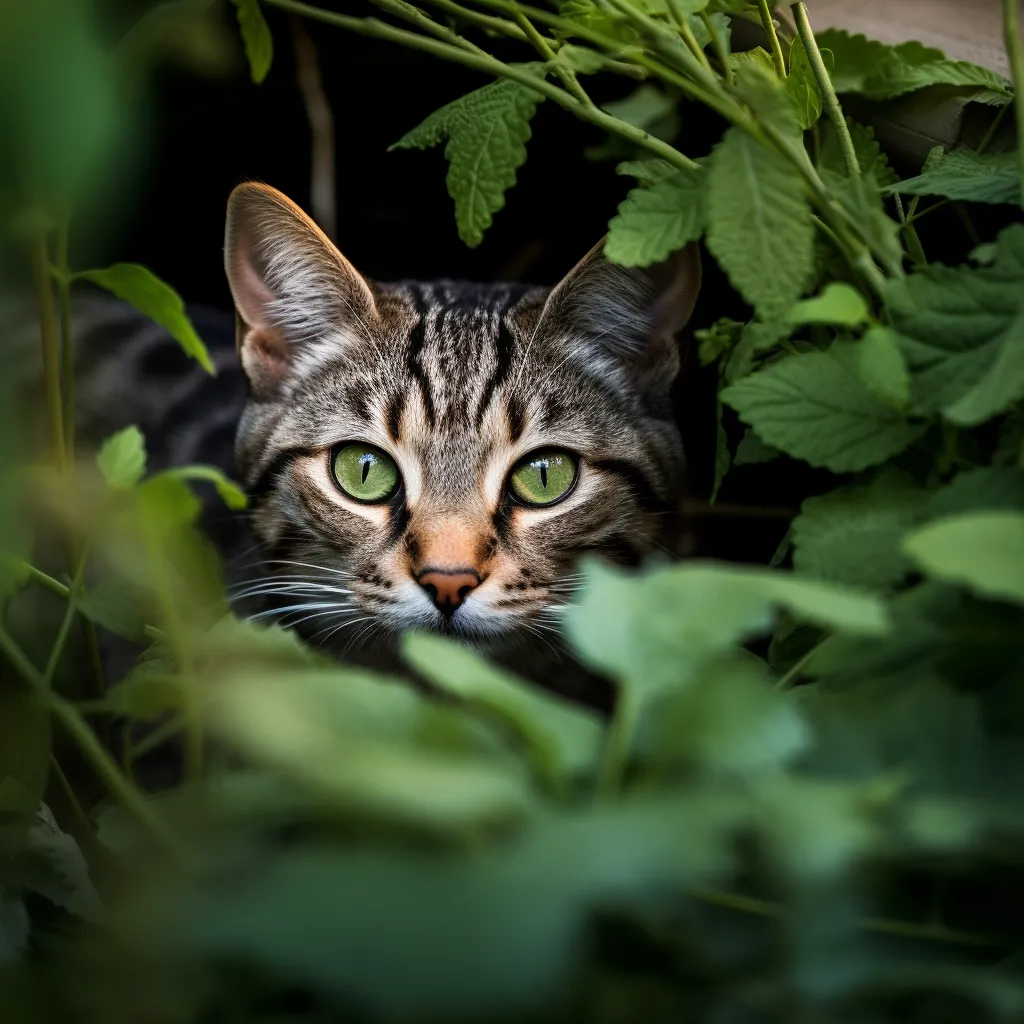Tips For Finding A Lost Cat
When searching for a lost cat, it's important to remember that there are several tips available to help in your search. It's worth trying out all of them or selecting the ones that are most suitable for your situation. The key is to remain calm and have faith that your cat will be found. With persistence and the implementation of these helpful strategies, there is a good chance of reuniting with your furry companion.
Start At The House
Cats, and especially little kittens, can be creative in finding tight and hard-to-reach spaces, where they can stay hidden for extended periods without responding to calls. Take the time to thoroughly inspect every corner, nook, and cranny of your house, including closets, cabinets, crawl spaces, and behind furniture. Don't forget to check high places like shelves and atop cabinets where cats often seek solitude. By searching every inch of your home, you increase the chances of locating your cat.
Check The Neighborhood
Extend your efforts beyond your own home and check the neighborhood. Inform your neighbors about your missing cat and ask for their permission to search their yards, garages, and other outdoor areas. Cats may wander into neighboring properties or seek shelter in hidden spots. Collaborating with your neighbors can greatly expand the search radius and increase the chances of finding your missing cat. Remember to provide them with a description or photo of your cat so they can keep an eye out as well.

Make Fliers, Social Media Posts
Creating fliers and social media posts can be an effective way to spread the word. Design eye-catching fliers with a clear photo of your cat, a brief description, your contact information, and the location where your cat was last seen. Post these fliers in public places such as community bulletin boards, local shops, veterinary clinics, and pet-related businesses. Additionally, share the information on social media platforms, local community groups, and lost and found pet pages.
Another helpful step is to leave a listing on Pet911 website, which specializes in connecting lost pets with their owners. Many people browse this platform when searching for missing pets, so posting a listing with your cat's description and your contact details can potentially lead to a successful reunion. By using both traditional methods like fliers and modern platforms like social media, you increase the chances of someone spotting your lost cat and reaching out to you.
Set Up A Trap
Setting up a trap can be a working strategy. There are specialized humane traps available for cats, designed to safely capture them without causing harm. These traps typically have a door that closes once the cat enters, allowing you to secure them until you can safely retrieve them.
To effectively use a trap, place it in an area where you believe your cat may frequent or where there have been sightings. Use enticing bait such as its favorite food or treats to attract it into the trap. Monitor the trap regularly and be prepared to act swiftly once your cat is captured.
Update Your Cat’s Microchip Info
Contact the microchip registry to update your current contact details and indicate that your cat is missing. This helps veterinary professionals and animal shelters identify and notify you if your cat is found. Regularly check and update the microchip information even when your cat is not lost to maximize the chances of a successful reunion.
Search Again After Nightfall
Cats often hide during the day and may be hesitant to come out due to stress or because of noise and activity outside. However, at night, when it's quieter and calmer, they may feel more comfortable going out of their shelter. Use a flashlight and search carefully in and around your property, paying attention to hiding spots and areas where cats are likely to seek shelter.
Notify Your Local Police Department
Notifying your local police department can be a helpful step when searching for a lost cat. While they may not directly handle animal-related matters, they can provide valuable information and guidance. Inform them about your missing cat, including its description and any unique identifying features. They may be aware of any recent sightings or have suggestions on how to effectively spread the word in the community. Remember to also contact animal control or the non-emergency line for any relevant local agencies that specialize in lost and found pets. Their assistance can contribute to increasing the chances of finding your cat.

How To Find A Hiding Cat
Cats can stay hidden in their shelters for extended periods. It's important not to lose hope and to continue searching for them every evening. One effective strategy is to entice them with their favorite food or treats, gradually luring them out of their hiding spot. Be patient and persistent, as it may take time for the cat to feel comfortable enough to emerge. Create a calm and quiet environment to avoid scaring them away, and consider using soft and soothing tones when calling their name.
How To Find A Lost Cat At Night
Cats are generally more active during nighttime hours, making it a prime time to search for them. Use a flashlight or headlamp to illuminate dark areas and increase visibility. Move slowly and quietly to avoid startling the cat, and listen carefully for any sounds or movements that may indicate their presence. Additionally, consider using enticing food or treats as a means to lure them out of hiding. Remember to stay patient and persistent, as it may take time for the cat to respond to your calls.
How To Find A Lost Cat In The Woods
Finding a lost cat in the woods can be challenging, but there are a few key places to search first. Check around the edges of the woods, near any known hiding spots, and near trails or paths where the cat may have wandered. Look for signs of the cat's presence, such as footprints or disturbed foliage. Use a flashlight to search in dark or dense areas, and listen for any meowing or rustling sounds. Consider setting up a trail of familiar scents using the cat's bedding or a litter box, and use a humane trap baited with their favorite food.
How To Find A Lost Cat In Your House
Finding a lost cat in your house may seem straightforward, but it's not always easy. With many hiding spots and their natural ability to stay silent, cats can be elusive. Start by thoroughly searching each room, checking under furniture, inside closets, and behind curtains. Look for any signs of the cat's presence, such as knocked-over items or scattered litter. Use enticing sounds, like shaking a treat bag, to lure the cat out of hiding. If needed, create a calm and quiet environment by closing off other rooms and minimizing noise. Additionally, consider setting up a comfortable space with familiar items, such as their bed or blanket, as it may attract the cat to come out.
Search Hiding Spots
When searching for a lost cat, start by checking their favorite and obvious hiding spots. Cats often have preferred areas they retreat to, such as under the bed or behind furniture. However, don't overlook any corner or crevice, as cats can hide anywhere they please. Inspect closets, cabinets, and even small openings where they may squeeze into. Pay attention to unusual nooks and crannies, like inside storage boxes or behind appliances. Be thorough in your search, as cats are skilled at finding the most unexpected hiding spots. Remember to remain patient and persistent until you locate your furry friend.

Look In High Places
Cats are natural climbers and may seek refuge on elevated surfaces. Check the tops of shelves, bookcases, or cabinets where they can perch and observe their surroundings. Don't overlook tall furniture like wardrobes or tall dressers, as cats may climb up and hide there. Use a flashlight to peer into upper corners and check for any signs of your cat. Remember to approach these areas calmly and quietly, as sudden movements or loud noises may cause them to retreat further. By thoroughly searching high places, you increase your chances of finding your missing cat.
Inspect Warm Places
Cats are naturally drawn to warmth and may seek out cozy spots to curl up in. Check near heating vents, radiators, or warm appliances like refrigerators or laundry machines. Pay attention to sunny spots near windows or doors where sunlight streams in. Don't forget to look inside closets, under beds, or behind furniture, as these areas can retain heat. Be thorough in your inspection of warm places, as your cat may have found comfort in these cozy nooks.
What Are The Chances Of Finding A Lost Cat
The chances of finding a lost cat can vary depending on several factors. It's important to act quickly and employ effective search strategies to maximize your chances. If your cat is familiar with the area and hasn't traveled far, the chances of finding them may be higher. Additionally, if your cat is microchipped or wearing a collar with identification, the chances of being reunited are increased as well. However, if your cat is shy or easily frightened, they may hide for an extended period, making the search more challenging. Ultimately, every situation is unique, but by being proactive, persistent, and utilizing various search methods, you can improve the likelihood of finding your lost cat. Don’t forget to leave a listing on Pet911 website and check the catalogue of found cats in case someone has found your cat and left a notice.

When To Stop Looking For A Lost Cat
Knowing when to stop looking for a lost cat can be a difficult decision. However, there are a few factors to consider. If your cat has been missing for an extended period of time, such as several weeks or months, and there have been no sightings or leads, it may be necessary to shift your focus to other measures. Keep in mind that cats are resilient and resourceful, and there is always a chance they may return on their own. However, if you have exhausted all possible avenues, it might be time to redirect your efforts towards accepting the situation and finding closure.
Remember to continue monitoring local shelters and online platforms periodically, as there is still a possibility that your cat could be found and brought in at a later time. Additionally, consider reaching out to local animal shelters, rescue organizations, and veterinary clinics to inquire if any cats matching your description have been brought in. Networking and spreading the word within your community can greatly increase the chances of finding your lost cat. Stay hopeful and persistent in your search efforts, as there is always a chance that your cat will be reunited with you.

